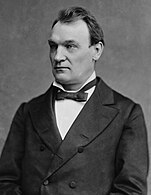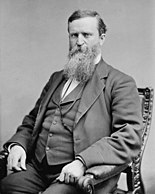U.S. House election, 1884
|
|
|||||||||||||||||||||||||||||||||
|---|---|---|---|---|---|---|---|---|---|---|---|---|---|---|---|---|---|---|---|---|---|---|---|---|---|---|---|---|---|---|---|---|---|
|
|||||||||||||||||||||||||||||||||
|
All 325 seats to the United States House of Representatives 163 seats were needed for a majority |
|||||||||||||||||||||||||||||||||
|
|||||||||||||||||||||||||||||||||
|
|||||||||||||||||||||||||||||||||
John G. Carlisle
Democratic Party (United States)
Elections to the United States House of Representatives were held in 1884 for Representatives in the 49th Congress. These election coincided with the election of President Grover Cleveland.
In spite of Cleveland's victory, the opposition Republican Party gained back some of the seats lost in 1882, but the Democratic Party retained a majority in the House. Republicans were able to make these slight gains by connecting their pro-business and industry message with progress. The Democrats were also hindered by the Panic of 1884, but were not greatly affected by it since the depression ended quickly.
In 1884, four states, with 28 seats among them, held elections early:
Party abbreviations
Two new districts were created for the seats gained in the 1882 reapportionment, eliminating the at-large district that had been created for them.
...
Wikipedia




